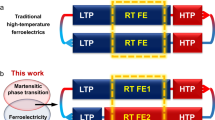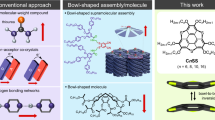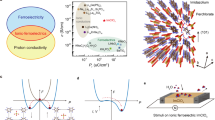Abstract
Ferroelectricity results from one of the most representative phase transitions in solids, and is widely used for technical applications. However, observations of ferroelectricity in organic solids have until recently been limited to well-known polymer ferroelectrics and only a few low-molecular-mass compounds. Whereas the traditional use of dipolar molecules has hardly succeeded in producing ferroelectricity in general, here we review advances in the synthesis of new organic materials with promising ferroelectric properties near room temperature, using design principles in analogy to inorganic compounds. These materials are based on non-covalent molecules formed by two or more components, in which ferroelectricity arises either from molecular displacements or from the collective transfer of electrons or protons. The principle of using multi-component molecular compounds leads to a much broader design flexibility and may therefore facilitate the development of future functional organics.
This is a preview of subscription content, access via your institution
Access options
Subscribe to this journal
Receive 12 print issues and online access
$259.00 per year
only $21.58 per issue
Buy this article
- Purchase on Springer Link
- Instant access to full article PDF
Prices may be subject to local taxes which are calculated during checkout







Similar content being viewed by others
References
Lines, M. E. & Glass, A. M. Principles and Applications of Ferroelectrics and Related Materials (Oxford Univ. Press, New York, 1977).
Valasek, J. Piezo-electric and allied phenomena in Rochelle salt. Phys. Rev. 17, 475–481 (1921).
Dawber, M., Rabe, K. M. & Scott, J. F. Physics of thin-film ferroelectric oxides. Rev. Mod. Phys. 77, 1083–1130 (2005).
Hoshino, S., Mitsui, T., Jona, F. & Pepinsky, R. Dielectric and thermal study of tri-glycine sulfate and tri-glycine fluoberyllate. Phys. Rev. 107, 1255–1258 (1957).
Furukawa, T. Ferroelectric properties of vinylidene fluoride copolymers. Phase Trans. 18, 143–211 (1989).
Sessler, G. M. Piezoelectricity in polyvinylidenefluoride. J. Acoust. Soc. Am. 70, 1596–1608 (1981).
Sworakowski, J. Ferroelectricity and related properties of molecular solids. Ferroelectrics 128, 295–306 (1992).
Shiozaki, Y., Nakamura, E. & Mitsui, T. (eds) Landolt–Börnstein Numerical Data and Functional Relationships in Science and Technology New Series, Group III (Crystal and Solid State Physics), Vols 16 (1982), 28 (1990) and 36 (2006) (Springer, Berlin).
Furukawa, T., Date, M. & Fukada, E. Hysteresis phenomena in polyvinylidene fluoride under high electric field. J. Appl. Phys. 51, 1135–1141 (1980).
Noda, K. et al. Remanent polarization of evaporated films of vinylidene fluoride oligomers. J. Appl. Phys. 93, 2866–2870 (2003).
Taylor, G. W. (ed.). Ferroelectric Liquid Crystals — Principles, Preparations and Applications (Gordon & Breach, New York, 1991).
Largerwall, S. T. Ferroelectric and Antiferroelectric Liquid Crystals (Wiley-VCH, Weinheim, 1999).
Solomon, A. L. Thiourea, a new ferroelectric. Phys. Rev. 104, 1191 (1956).
Goldsmith, G. J. & White, J. G. Ferroelectric behavior of thiourea. J. Chem. Phys. 31, 1175–1187 (1959).
Dénoyer, F. & Currat, R. in Incommensurate Phases in Dielectrics Part 2 (Materials) (eds Blinc, R. & Levanyuk, A. P.) 129–160 (North-Holland, Amsterdam, 1986).
Bordeaux, D., Bornarel, J., Capiomont, A. & Lajzerowicz-Bonneteau, J. New ferroelastic-ferroelectric compound: tanane. Phys. Rev. Lett. 31, 314–317 (1973).
Lipscomb, G. F., Garito, A. F. & Wei, T. S. An apparent ferroelectric transition in an organic diacetylene solid. Ferroelectrics 23, 161–172 (1980).
Schultes, H., Strohriegl, P. & Dormann, E. Pyroelectric properties for single crystals of the disubstituted diacetylene DNP. Ferroelectrics 70, 161–173 (1986).
Gruner-Bauer, P. & Dormann, E. The ferroelectric low-temperature phase of single crystals of the substituted diacetylene 1,6-bis(2,4-dinitrophenoxy)-2,4-hexadiyne (DNP). J. Phys. Condens. Matter 4, 5599–5609 (1992).
Choudhury, R. R. & Chitra, R. Molecular symmetry and ferroelectricity in pure organic molecular crystals. Cryst. Res. Technol. 41, 1045–1048 (2006).
Zikmund, Z. et al. Search for new molecular organic ferroelectrics. Ferroelectrics 58, 223–228 (1994).
Kroupa, J., Vanẽk, P., Krupkova, R. & Zikmund, Z. Dielectric and optical properties of weak ferroelectric cyclohexan-1,1′-diacetic acid. Ferroelectrics 202, 229–234 (1997).
Koval, S., Kohanoff, J., Lasave, J., Colizzi, G. & Migoni, R. L. First-principles study of ferroelectricity and isotope effects in H-bonded KH2PO4 crystal. Phys. Rev. B 71, 184102 (2005).
Szklarz, P. & Bator, G. Pyroelectric properties of tricyclohexylmethanol (TCHM) single crystal J. Phys. Chem. Solids 66, 121–125 (2005).
Yamamura, Y., Saitoh, H., Sumita, M. & Saito, K. One-dimensional correlation in the dipolar Ising crystal tricyclohexylmethanol: crystal structure revisited and heat capacity. J. Phys. Condens. Matter 19, 176219 (2007).
Bator, G., Jakubas, R. & Malarski, Z. Molecular dynamics in the α,α-dicyclohexyl-cyclohexanemethanol single crystal [(C6H11)3COH]. J. Phys. C 19, 2799–2809 (1986).
Semmingsen, D. & Feder, J. A structural phase transition in squaric acid. Solid State Commun. 15, 1369–1372 (1974).
Feder, J. Two-dimensional ferroelectricity. Ferroelectrics 12, 71–84 (1976).
Ishii, F., Nagaosa, N., Tokura, Y. & Terakura, K. Covalent ferroelectricity in hydrogen-bonded organic molecular systems. Phys. Rev. B 73, 212105 (2006).
Sugawara, T. & Takasu, I. Tautomerism in the solid state. Adv. Phys. Org. Chem. 32, 219–265 (1999).
Gilli, G., Bellucci, F., Ferretti, V. & Bertolasi, V. Evidence for resonance-assisted hydrogen bonding from crystal-structure correlations on the enol form of the β-diketone fragment, V. J. Am. Chem. Soc. 111, 1023–1028 (1989).
Katrusiak, A. Stereochemistry and transformation of −OH···O= hydrogen bonds. Part I. Polymorphism and phase transition of 1,3-cyclohexanedione crystal. J. Mol. Struct. 269, 329–354 (1992).
Sugawara, T. et al. Organic paraelectrics resulting from tautomerization coupled with proton-transfer. Solid State Commun. 83, 665–668 (1992).
Mochida, T., Izuoka, A., Sugawara, T., Moritomo, Y. & Tokura, Y. Organic hydrogen-bonded dielectrics: quantum paraelectricity based on tautomerization of 9-hydroxyphenalenone derivatives. J. Chem. Phys. 101, 7971–7973 (1994).
Takasu, I., Izuoka, A., Sugawara, T. & Mochida, T. Observation of quantum paraelectricity in an intermolecular ionic hydrogen-bonded crystal of a squaric acid derivative. J. Phys. Chem. B 108, 5527–5531 (2004).
Szafrański, M., Katrusiak, A. & McIntyre, G. J. Ferroelectric order of parallel bistable hydrogen bonds. Phys. Rev. Lett. 89, 215507 (2002).
Katrusiak, A. & Szafrański, M. Disproportionation of pyrazine in N–H+···N hydrogen-bonded complexes: new materials of exceptional dielectric response. J. Am. Chem. Soc. 128, 15775–15785 (2006).
Tokura, Y. et al. Domain-wall dynamics in organic charge-transfer compounds with one-dimensional ferroelectricity. Phys. Rev. Lett. 63, 2405–2408 (1989).
Okamoto, H. et al. Anomalous dielectric response in tetrathiafulvalene-p-chloranil as observed in temperature- and pressure-induced neutral-to-ionic phase transition. Phys. Rev. B 43, 8224–8232 (1991).
Le Cointe, M. et al. Symmetry breaking and structural changes at the neutral-to-ionic transition in tetrathiafulvalene-p-chloranil. Phys. Rev. B 51, 3374–3386 (1995).
García, P., Dahaoui, S., Fertey, P. & Lecomte, C. Crystallographic investigation of temperature-induced phase transition of the tetrathiafulvalene-p-bromanil, TTF-BA charge transfer complex. Phys. Rev. B 72, 104115 (2005).
Torrance, J. B., Vazquez, J. E., Mayerle, J. J. & Lee, V. Y. Discovery of a neutral-to-ionic phase transition in organic materials. Phys. Rev. Lett. 46, 253–257 (1981).
Torrance, J. B. et al. Anomalous nature of neutral-to-ionic phase transition in tetrathiafulvalene-chloranil. Phys. Rev. Lett. 47, 1747–1750 (1981).
Horiuchi, S., Okimoto, Y., Kumai, R. & Tokura, Y. Anomalous valence fluctuation near a ferroelectric transition in an organic charge-transfer complex. J. Phys. Soc. Jpn 69, 1302–1305 (2000).
Okimoto, Y., Horiuchi, S., Saitoh, E., Kumai, R. & Tokura Y. Far-infrared optical response of neutral–ionic phase transition in an organic charge-transfer complex. Phys. Rev. Lett. 87, 187401 (2001).
Girlando, A., Painelli, A., Bewick, S. A. & Soos, Z. G. Charge fluctuations and electron–phonon coupling in organic charge-transfer salts with neutral–ionic and Peierls transitions. Synth. Metals 141, 129–138 (2004).
Horiuchi, S., Okimoto, Y., Kumai, R. & Tokura, Y. Quantum phase transition in organic charge-transfer complexes. Science 299, 229–232 (2003).
Soos, Z. G., Bewick, S. A., Peri, A. & Painelli, A. Dielectric response of modified Hubbard models with neutral–ionic and Peierls transitions. J. Chem. Phys. 120, 6712–6720 (2004).
Nad, F. & Monceau, P. Dielectric response of the charge ordered state in quasi-one-dimensional organic conductors. J. Phys. Soc. Jpn 75, 051005 (2006).
Girlando, A., Pecile, C. & Torrance, J. B. A key to understanding ionic mixed stacked organic solids: tetrathiafulvalene-bromanil (TTF-BA). Solid State Commun. 54, 753–759 (1985).
Horiuchi, S., Kumai, R., Okimoto Y. & Tokura, Y. Order–disorder transition of nonplanar molecules and dielectric anomaly in a crystal of charge-transfer complex. J. Am. Chem. Soc. 121, 6757–6758 (1999).
Horiuchi, S., Kumai, R., Okimoto Y. & Tokura, Y. Chemical approach to neutral–ionic valence instability, quantum phase transition, and relaxor ferroelectricity in organic charge-transfer complexes. Chem. Phys. 325, 78–91 (2006).
Tokura, Y., Okamoto, H., Koda, T., Mitani, T. & Saito, G. Nonlinear electric transport and switching phenomenon in the mixed-stack charge-transfer crystal tetrathiafulvalene-p-chloranil. Phys. Rev. B 38, 2215–2218 (1988).
Lehn, J.-M. Supramolecular Chemistry: Concepts and Perspectives (VCH, Weinheim, 1995).
Horiuchi, S. et al. Ferroelectricity near room temperature in co-crystals of nonpolar organic molecules. Nature Mater. 4, 163–166 (2005).
Kumai, R., Horiuchi, S., Okimoto, Y. & Tokura, Y. Large dielectric susceptibility associated with proton transfer in a supramolecular structure of chloranilic acid and 5,5′-dimethyl-2,2′-bipyridine. J. Chem. Phys. 125, 084715 (2006).
Horiuchi, S., Kumai, R. & Tokura, Y. A supramolecular ferroelectric realized by collective proton transfer. Angew. Chem. Int. Ed. 46, 3497–3501 (2007).
Wallenfels, K. & Friedrich, K. Zur Hydrolyse und Alkolyse des Fluoranils. Chem. Ber. 90, 3070–3082 (1957).
Perrin, D. D. Dissociation Constants of Organic Bases in Aqueous Solution (Butterworths, London, 1965); Supplement (Butterworths, London, 1972).
Zaman, M. B., Tomura, M. & Yamashita, Y. Crystal engineering using anilic acids and dipyridyl compounds through a new supramolecular synthon. J. Org. Chem. 66, 5987–5995 (2001).
Almeida, A. et al. Pyroelectric effect in benzyl. Ferroelectrics 79, 253–256 (1988).
Horiuchi, S., Kumai, R. & Tokura, Y. Room-temperature ferroelectricity and gigantic dielectric susceptibility on a supramolecular architecture of phenazine and deuterated chloranilic acid. J. Am. Chem. Soc. 127, 5010–5011 (2005).
Saito, K., Amano, M., Yamamura, Y., Tojo, T. & Atake, T. Low-temperature phase transitions of an organic ferroelectrics, phenazine–chloranilic acid. J. Phys. Soc. Jpn 75, 033601 (2006).
Gotoh, K., Asaji, T. & Ishida, H. Hydrogen bonding in two solid phases of phenazine-chloranilic acid (1/1) determined at 170 and 93 K. Acta Cryst. C 63, o17–o20 (2007).
Asaji, T. et al. Phase transition and temperature dependent electronic state of an organic ferroelectric, phenazine-chloranilic acid (1:1). J. Phys. Condens. Matter 19, 226203 (2007).
Kumai, R. et al. Structural assignment of polarization in hydrogen-bonded supramolecular ferroelectrics. J. Am. Chem. Soc. 129, 12920–12921 (2007).
Steiner, T. The hydrogen bond in the solid state. Angew. Chem. Int. Ed. 41, 48–76 (2002).
Steiner, T., Majerz, I. & Wilson, C. C. First O–H–N hydrogen bond with a centered proton obtained by thermally induced proton migration. Angew. Chem. Int. Ed. 40, 2651–2654 (2001).
Resta, R. Macroscopic polarization in crystalline dielectrics: the geometric phase approach. Rev. Mod. Phys. 66, 899–915 (1994).
Cohen, R. E. Origin of ferroelectricity in perovskite oxides. Nature 358, 136–138 (1992).
Lang, S. B. & Das-Gupta, D. K. in Handbook of Advanced Electronic and Photonic Materials and Devices Vol. 4 (Ferroelectrics and Dielectrics) (ed. Nalwa, H. S.) 1–55 (Academic, San Diego, 2001).
Iwai, S. & Okamoto, H. Ultrafast phase control in one-dimensional correlated electron systems. J. Phys. Soc. Jpn 75, 011007 (2006).
Nasu, K. (ed.). Photoinduced Phase Transitions (World Scientific, Singapore, 2004).
Collet, E. et al. Laser-induced ferroelectric structural order in an organic charge-transfer crystal. Science 300, 612–615 (2003).
Naber, R. C. G. et al. High-performance solution-processed polymer ferroelectric field-effect transistors. Nature Mater. 4, 243–248 (2005).
Hiraoka, M. et al. On-substrate synthesis of molecular conductor films and circuits. Adv. Mater. 19, 3248–3251 (2007).
Kamishima, Y., Akishige, Y. & Hashimoto, M. Ferroelectricity activity on organic crystal trichloroacetamide. J. Phys. Soc. Jpn 60, 2147–2150 (1991).
Akishige, Y. & Kamishima, Y. Weak ferroelectricity on organic crystal trichloroacetamide. J. Phys. Soc. Jpn 70, 3124–3128 (2001).
Murakami, E., Komukae, M., Osaka, T. & Makita, Y. Ferroelectricity in 3C6H4(OH)2·CH3OH. J. Phys. Soc. Jpn 59, 1147–1149 (1990).
Acknowledgements
We thank R. Kumai, Y. Tokunaga, F. Ishii, N. Nagaosa, Y. Okimoto, T. Hasegawa, T. Arima and Y. Noda for discussions and collaborations in experiments. S.H. is grateful for support by a Grant-in-Aid for Scientific Research (no. 18750133) from the Ministry of Education, Culture, Sports, Science and Technology of Japan.
Author information
Authors and Affiliations
Rights and permissions
About this article
Cite this article
Horiuchi, S., Tokura, Y. Organic ferroelectrics. Nature Mater 7, 357–366 (2008). https://doi.org/10.1038/nmat2137
Issue Date:
DOI: https://doi.org/10.1038/nmat2137
This article is cited by
-
Two-dimensional ferroelectricity in a single-element bismuth monolayer
Nature (2023)
-
Proton-controlled molecular ionic ferroelectrics
Nature Communications (2023)
-
Superior ferroelectricity and nonlinear optical response in a hybrid germanium iodide hexagonal perovskite
Nature Communications (2023)
-
Discovery of ferroelectricity in natural product androstane
Discover Materials (2023)
-
Anisotropic fluid with phototunable dielectric permittivity
Nature Communications (2022)



